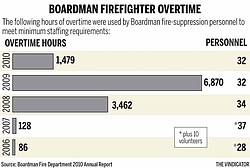Dispute over fire staffing heats up in Boardman
SEE ALSO:
Boardman groups seek bigger signs of welcome
DEBATE CENTERS ON OVERTIME AND SAFETY
BOARDMAN
A day of back-and-forth between the township and the firefighters union over staffing levels and overtime ended with the township administration issuing a sharp rebuke late Tuesday.
Harry Wolfe, president of the International Association of Firefighters Local 1176, issued a news release Monday that stated the “department is under-staffed and that public safety is threatened.”
The administration disagrees and said its concern is that overtime hours for the first three months of 2011 are four times larger than the same time period in 2010. The fire department had 910 hours of overtime from January to March 2011 compared with 234 hours in 2010.
In a statement released Tuesday night, the trustees said the board would not engage in “fear mongering” and will:
Direct Township Administrator Jason Loree to discontinue first-responder services and contract with an emergency medical service company.
Direct Loree to examine re-instituting the volunteer firefighters into the regular operations of the department to bolster staffing.
Direct Loree to research the possibility of having firefighters assessed for their physical abilities in the performance their duties.
Direct Loree to investigate a joint fire district.
Central to the union’s concern is maintaining minimum staffing requirements for the department, which is nine firefighters per shift, per the contract. Usually four firefighters are stationed at the central U.S. Route 224 station, three at the Lockwood/Shields Station and two at the South Avenue station, Wolfe said.
Loree said the latest negotiations increased the minimum manning for stations from eight to nine, with the stipulation that if the township has to call out more firefighters because staffing drops below nine — because of sick days or vacation — five times, then the trustees can review the practice and decide whether to continue it.
The contract took effect April 1, and within the first week, the fire department had more than five “call-outs.”
Trustee Brad Calhoun said the administration is looking into ways to reduce overtime costs.
“We wouldn’t be doing our job if we weren’t looking at ways to control overtime, and we’re trying to control overtime through the minimum staffing levels,” he said, adding “no decisions [have] been made” regarding minimum staffing levels.
In 2010, firefighters worked 1,479 hours of overtime to maintain the minimum staffing level — a sharp decrease from the 6,870 hours in 2009.
The March monthly report stated manpower was down 11 firefighters: two injured on duty, three laid off, three retired and three vacancies.
Wolfe said he believes that the township is unfairly blaming firefighters for overtime costs, when trustees could alleviate the problem by hiring new firefighters at the newly negotiated starting wage of $24,000 annually.
“In 2008 before the layoffs, we had 13 firemen on each shift with eight-man minimum staffing, and that gave you a five-man cushion. If someone was sick or hurt, we didn’t have overtime,” Wolfe said.
Calhoun said he agrees with Wolfe that the department is understaffed, but the time is not right for hiring.
“I do believe they are understaffed because that’s what’s leading to some of the overtime. But we certainly can’t afford at this point to be adding staff. I would love to have the opportunity to have part-timers, but it’s not part of the deal right now,” Calhoun said.
Wolfe said he was concerned about the township administration making the firefighters scapegoats.
“We’re always reacting to [the administration’s] tactics, and we decided to go on the offensive. They’ll be fighting and mad at us. ... My whole reason [for the release] was to try to inform the public, and that we’re no longer going to stand for this,” he said.
Calhoun said residents are in no danger with current staffing levels or if levels would be further reduced.
“In the press release, [Wolfe] is setting himself up for the fight we might have if we pull out the minimum manning to go to less than nine,” Calhoun said. “... I don’t aspire or desire to put six [firefighters] out there.”
Still, Calhoun said, it’s possible to have two firefighters at each of the township’s three stations.
Loree said the township abides by its contract with the local IAFF and follows National Fire Protection Association standards.
NFPA standards recommend four firefighters in a fire engine and has a two in/two out rule, which requires two firefighters outside the hazardous area who monitor the two in the hazardous area and can rescue them if they get into trouble, according to the NFPA website.
“People want to know if it’s safe, and we refer back to NFPA, and before [firefighters] can enter a burning building, you have to have four firefighters on scene. Whether it’s three in a truck that we were running prior, you’d still have to wait for another truck to bring a fourth person,” Loree said.
Calhoun said if and when the township uses an outside service to handle medical calls, firefighters could still handle those calls if an ambulance service wasn’t available.
The situation “is no fault of the firemen. Their contract calls for nine for staffing. They have vacations, injuries, retirements, and I wouldn’t expect anything else from them than to negotiate a safe [staffing] number,” Calhoun said.
The Boardman Fire Department responded to 3,732 calls in 2010, of which 2,833 were EMS calls. Last year, the average response time was four minutes and 26 seconds.
Austintown Fire Chief Andy Frost Jr. said his department currently has three firefighters per truck, and has six full-time firefighters working each shift, but part-time firefighters can be called out to assist.
“In our new contract that they just got done negotiating, it’s possible to go down to less. We’re only going to do that if we absolutely have to. If the township runs out of money, it can go down to two men,” Frost said.
 43
43

